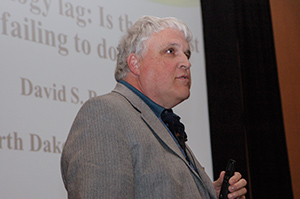Live Animal, Carcass and End Product Committee:
Technology Lag: Is There A Cost
For Failing to Do It Right?
by Troy Smith, field editor, for Angus Journal®
OKLAHOMA CITY, Okla. (June 13, 2013) — Considering the rate of world population growth and the growing global demand for animal protein, it is estimated that, by 2050, world-wide beef production must increase by some 60%. So said North Dakota State University animal scientist David Buchanan during the 2013 Beef Improvement Federation Research Symposium and Convention in Oklahoma City. Speaking to the Live Animal, Carcass and End Product Committee, Buchanan said meeting the expected growth in demand for beef will require advanced technologies and a willingness to use them.

David Buchanan
“There is a sizable investment being made in agricultural research, which should result in new technologies, but it takes time for development and adoption, and then for the benefits to be realized. Historically, it takes about 30 years. We don’t have 30 years,” warned Buchanan.
Recounting advancements in genetics and management of crops and food animals, Buchanan said modern agricultural technologies have prevented population growth from outpacing food production. He noted how pounds of beef carcass produced per cow in the United States grew from 450 pounds (lb.) in 1980 to approximately 630 lb. in 2005. Citing the influence of genetic selection, Buchanan said further advancement in productivity will depend on wise use of selection resources.
Buchanan said general trends toward increased calving ease, weaning weight, yearling weight, marbling and ribeye area illustrate industry emphasis on selection for increased efficiency of the calf from birth to harvest. Market signals have not exerted as much pressure on reproduction, relative to production. Buchanan said addressing the life-cycle cost of producing a pound of edible meat protein will have to include consideration of cow-side factors such as replacement rate, feed for maintenance, gestation and lactation.
The kinds of tools that have aided selection so far — a broad array of expected progeny differences (EPDs), selection indices and genomic enhanced EPDs — are reasons why Buchanan is optimistic about the future.
“We’ve done pretty well, but we could do better,” stated Buchanan. “But better selection tools just get us into trouble faster if we aren’t selecting for the right things.”
Return to the Newsroom for links to the PowerPoint presentation that accompanied this presentation.
-----------------------------------------Editor’s Note: This summary was written under contract or by staff of Angus Productions Inc. (API). Through an agreement with the Beef Improvement Federation, we are encouraging reprinting of the articles to those who will adhere to the reprint guidelines available on this site. Please review those guidelines or contact Shauna Rose Hermel, editor, at 816-383-5270. PowerPoints are posted with permission of the presenter and may not be reproduced in whole or in part without the express permission of the presenter.
API's coverage of the event is made possible through collaboration with BIF and sponsorship of LiveAuctions.tv. For questions about this site, or to notify us of broken links, click here.
Headquartered in Saint Joseph, Mo., API publishes the Angus Journal, the Angus Beef Bulletin, the Angus Beef Bulletin EXTRA, and the Angus Journal Daily, as well as providing online coverage of events and topics pertinent to cattlemen through the Angus Journal Virtual Library.



